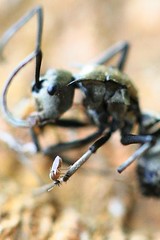After reading Paul Arden’s ‘Whatever You Think, Think the Opposite’, I was inspired to take some dead Insects instead of those alive and kicking. ‘Photograph dead roses instead of the live roses which thousand of photographers had been photographing’ kept ringing in my ears. So I spotted the most common of all dead insect – a dead ant hanging by a silk thread swinging in the breeze.
While I was photographing, I was constantly puzzling how did he died? Am I able to investigate the death of an ant? Interesting. It could make a good detective novel, unravelling the live of the micro-world. Am I autistic, like Mark Haddon had written? Who cares! I just want to be a kid again, pursuing the trivial.
What fly is that?
What ant is this?
What Spider is the culprit?

We had just identified the fly as ceratopogonid, thanks to Dr Brian.
Thanks to Omeuceu, we have the identity of the Ant and the spider.
The Fly
Kingdom: Animalia Phylum: Arthropoda Class: Insecta Order: Diptera Suborder: Nematocera Infraorder: Culicomorpha Superfamily: Chironomoidea Family: Ceratopogonidae ..................................................................... The Ant
Kingdom: Animalia Phylum: Arthropoda Subphylum: Hexapoda Class: Insecta Order: Hymenoptera Suborder: Apocrita Superfamily: Vespoidea Family: Formicidae Subfamily: Myrmicinae ..................................................................... The Spider
Kingdom: Animalia Phylum: Arthropoda Class: Arachnida Order: Araneae Suborder: Araneomorphae Family: Thomisidae Genus: Aphantochilus O. P-Cambridge, 1870 ..................................................................... Thanks all the Flickr Friend for helping to indentify the different insects and spider, especially Omeuceu, who are always so helpful. Here is what had captured from Flickr. omeuceu
see my website - Vida na Terra (Life in Earth) - www.vidanaterra.info - go to Araneae > Thmoisidae > Aphantochilus sp. (see the credits to know who takes the photo) - I have the best photo available in all net for Aphantochilus. (I never found it in flickr)
www.naturkundemuseum-karlsruhe.de/SMNK/02-For sch-I/02-05-...
www.projectamazonas.com/subpages/floraandfaun a/FloraFauna...
- to me, the page doesn´t work. :( ............................................................................................................ InSectHunter
en.wikipedia.org/wiki/Aphantochilus
Read a little from this site above. The three known species were found in Argentina, Brazil and Paraguay.
It is possible to have Aphantochilus in South East Asia? Interesting if I found one here.
Could it be another crab spider that eat ants,
habitatnews.nus.edu.sg/guidebooks/spiders/tex t/Amyciaea_l...

No comments:
Post a Comment